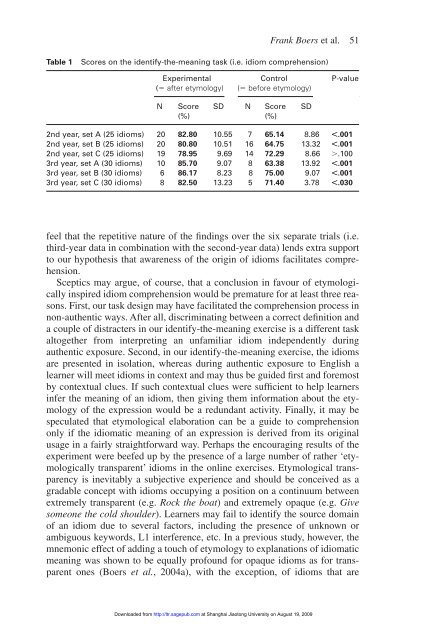Language Teaching Research
Language Teaching Research
Language Teaching Research
You also want an ePaper? Increase the reach of your titles
YUMPU automatically turns print PDFs into web optimized ePapers that Google loves.
Frank Boers et al. 51<br />
Table 1 Scores on the identify-the-meaning task (i.e. idiom comprehension)<br />
Experimental Control P-value<br />
( after etymology) ( before etymology)<br />
N Score SD N Score SD<br />
(%) (%)<br />
2nd year, set A (25 idioms) 20 82.80 10.55 7 65.14 8.86 .001<br />
2nd year, set B (25 idioms) 20 80.80 10.51 16 64.75 13.32 .001<br />
2nd year, set C (25 idioms) 19 78.95 9.69 14 72.29 8.66 .100<br />
3rd year, set A (30 idioms) 10 85.70 9.07 8 63.38 13.92 .001<br />
3rd year, set B (30 idioms) 6 86.17 8.23 8 75.00 9.07 .001<br />
3rd year, set C (30 idioms) 8 82.50 13.23 5 71.40 3.78 .030<br />
feel that the repetitive nature of the findings over the six separate trials (i.e.<br />
third-year data in combination with the second-year data) lends extra support<br />
to our hypothesis that awareness of the origin of idioms facilitates comprehension.<br />
Sceptics may argue, of course, that a conclusion in favour of etymologically<br />
inspired idiom comprehension would be premature for at least three reasons.<br />
First, our task design may have facilitated the comprehension process in<br />
non-authentic ways. After all, discriminating between a correct definition and<br />
a couple of distracters in our identify-the-meaning exercise is a different task<br />
altogether from interpreting an unfamiliar idiom independently during<br />
authentic exposure. Second, in our identify-the-meaning exercise, the idioms<br />
are presented in isolation, whereas during authentic exposure to English a<br />
learner will meet idioms in context and may thus be guided first and foremost<br />
by contextual clues. If such contextual clues were sufficient to help learners<br />
infer the meaning of an idiom, then giving them information about the etymology<br />
of the expression would be a redundant activity. Finally, it may be<br />
speculated that etymological elaboration can be a guide to comprehension<br />
only if the idiomatic meaning of an expression is derived from its original<br />
usage in a fairly straightforward way. Perhaps the encouraging results of the<br />
experiment were beefed up by the presence of a large number of rather ‘etymologically<br />
transparent’ idioms in the online exercises. Etymological transparency<br />
is inevitably a subjective experience and should be conceived as a<br />
gradable concept with idioms occupying a position on a continuum between<br />
extremely transparent (e.g. Rock the boat) and extremely opaque (e.g. Give<br />
someone the cold shoulder). Learners may fail to identify the source domain<br />
of an idiom due to several factors, including the presence of unknown or<br />
ambiguous keywords, L1 interference, etc. In a previous study, however, the<br />
mnemonic effect of adding a touch of etymology to explanations of idiomatic<br />
meaning was shown to be equally profound for opaque idioms as for transparent<br />
ones (Boers et al., 2004a), with the exception, of idioms that are<br />
Downloaded from<br />
http://ltr.sagepub.com at Shanghai Jiaotong University on August 19, 2009














